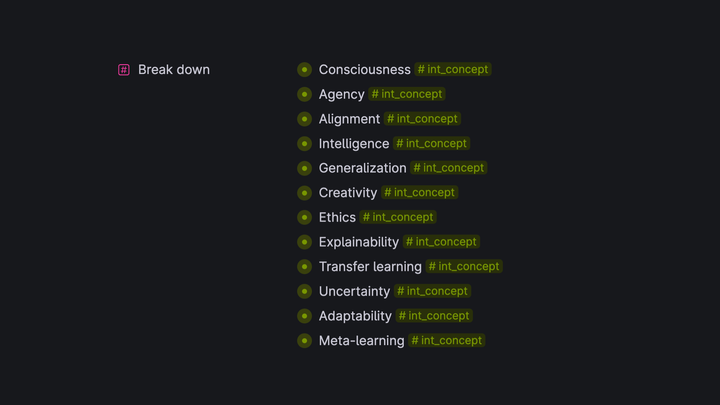Hey 👋 — Andrew is here.
Today’s issue of Tools For Thought is an attempt to define the category of TfT.
Issue will take about 6 minutes to read. Hope you enjoy it!
What are Tools for Thought?
It's a big question! Various interpretations exist.
I believe that in order for the category to develop, we need to have a clear definition.
Or, at the very least, a functional one. I'll try to come up with the definition by the end of this text
Let's dive in!
I'd like to start with the recent Maggie Appleton essay: "Tools for Thought as Cultural Practices, not Computational Objects"
Maggie reflects on the nature of Tools for Thought there.
She highlights the importance of cultural and historical aspects of TfT.
The following is a list she provides to show the progression of Tools for Thought throughout the history:
- Written language
- Drawing
- Maps
- Hindu-arabic numerals
- Epic poetry as oral history
- The Socratic method
- The scientific method
- Cartesian coordinates
- Zettelkastens
- Aboriginal songlines
- Spreadsheets
- Data visualization
Those are cultural practices, techniques, methods, and objects. And we can definitely label them as Tools For Thought.

We may attempt to broaden the field even further:
- Debates
- Focus groups
- Coffee
All of those things help us think. They can be classified as Tools for Thought.
However, this would result in a category with even fewer boundaries.
I think, therefore I am
Thinking is the extremely broad phenomena.
Basically, everything has the potential to aid our thinking.
Following this path it will be hard to find a better definition of TfT. I think we need more boundaries.
Computers
Nowadays, TfT are primarily associated with computers. Yet as we see from Maggie's examples, it is a recent shift.
Maggie says about computation:
Taken at face value, the phrase tool for thought doesn't have the word 'computer' or 'digital' anywhere in it. It suggests nothing about software systems or interfaces. It's simply meant to refer to tools that help humans think thoughts; potentially new, different, and better kinds of thoughts than we currently think.
Maggie argues that it would be a good idea to rename tools for Thought to Computational Mediums For Thought. Or CMFT for short.
I think it would make matters even less clear.
Obviously, the potential of computer-based TfT at the moment cannot be compared to any other tools. It is incomparably bigger.
So, looking forward, I believe it is critical to essential to establish Tools for Thought as a software category.
I think it will help a lot of people outside the TfT community to understand the field better.
Let's try to go in this direction. We can set up the clear lines here adopting the established rules.
Adobe Illustrator is a tool for drawing.
It is not a tool for note-taking. Yet, you can take notes there.
Apple Notes is a tool for note-taking. Not a tool for drawing. Yet you can draw there.
Apple Notes and Adobe Illustrator could also be called TfT, but they aren't.
I would argue that some specialized tools like AutoCAD or MATLAB are not TfT either. They definitely help engineers think, yet they are very narrow to be called Tools For Thought.
I think we should use "thought" as a reference to industry-agnostic thinking. Tools For Thought can bring benefits to engineers, scientists, doctors, entrepreneurs, musicians. And basically, to anyone who is involved in complex cognitive activity.
So we looked at classifying TfT as a software category (with clear boundaries)
Now let's try to discover a suitable metaphor.
Metaphors
Our ordinary conceptual system, in terms of which we both think and act, is fundamentally metaphorical in nature.
— George Lakoff, Mark Johnson. Metaphors We Live By
I think current metaphors do more harm than good in defining TfT.
Let's check the popular ones.
Bicycle for the mind
My problem with it is the following:
When you come off the bicycle — you are essentially the same person.
Probably your leg muscles are a bit stronger.
Your vestibular system is a bit more developed.
You could even have learnt a few routes.
But these changes are rather minor.
TfT provide us with new abilities and skills. We become better thinkers even when we are not using them.
Second brain
This metaphor is perhaps even less accurate.
Essentially when you externalize your notes, you don't get a "second brain"
At best, you would get an external memory.
If this is the only function of your second brain, I would say it's quite limited for the "brain".
We use TfT to enhance our one and only brain.
I think the metaphor should emphasize that.
Here is the metaphor I would propose:
AUGMENTED THINKING
As an analogy, consider augmented reality.
When we are in augmented reality, we obtain superpowers such as:
- ability to navigate
- see more details
- operate with “layers” of reality
Yet, with all the devices off, these abilities still have an impact on us.
Now when we have a metaphor, we can try to define the software category more precisely.
Definition
Let's visit another great essay: Andy Matuschak's and Michael Nielsen's.
A context in which the user can have new kinds of thought, thoughts that were formerly impossible for them
— Andy Matuschak and Michael Nielsen, How can we develop transformative tools for thought?
I really like the idea of context here.
Context, environment, space!
The concept of IDE is used in software development (Integrated Development Environment).
So how about we go:
Integrated Environment for Augmented Thinking
Roam Research, Obsidian, Logseq, Fermat, Heptabase, ...
I think all of the apps we categorize as Tools for Thought seem to fit the description quite well.
More on topic
Maggie Appleton, Tools for Thought as Cultural Practices, not Computational Objects
Andy Matuschak, Michael Nielsen, How can we develop transformative tools for thought?


